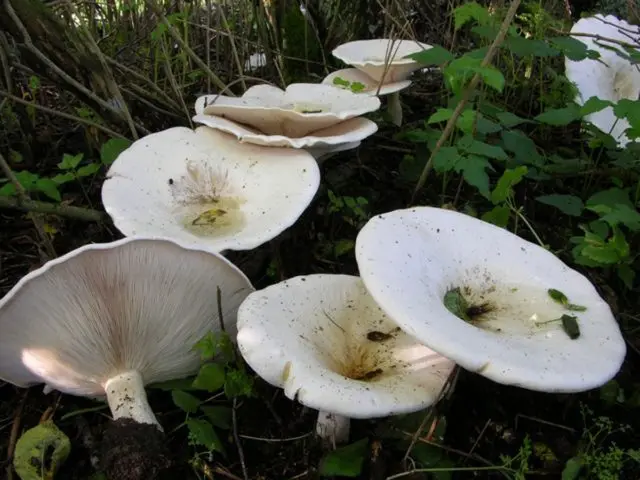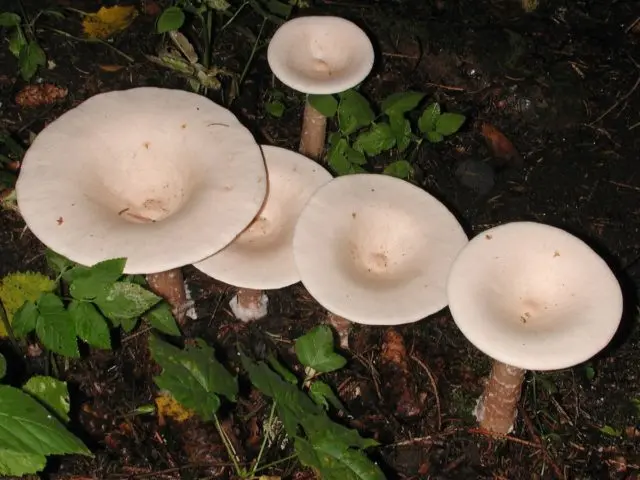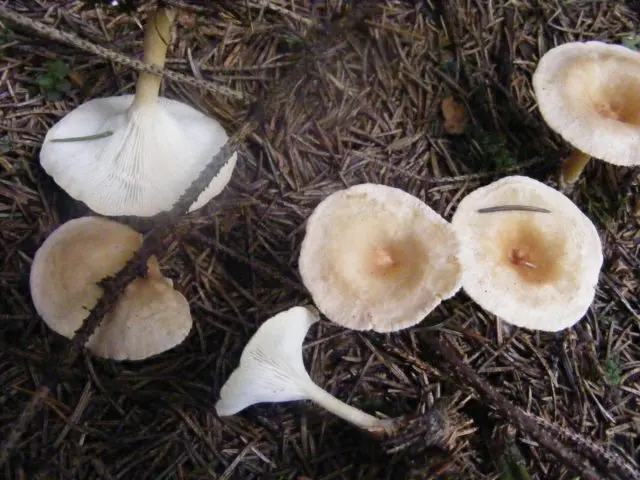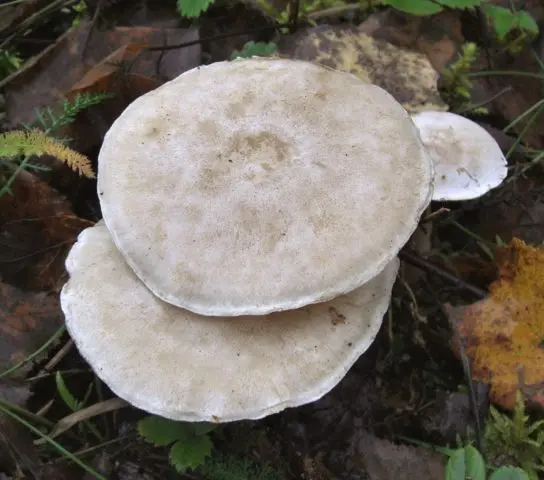Contents
The giant talker is a mushroom that is a representative of the Tricholomovye or Ryadovkovye family. This species is distinguished by its large size, for which it received its name. Also in other sources it is found as a giant row. It grows mainly in large groups, in the form of witch circles. The official name is Leucopaxillus giganteus.
Where giant talkers grow
The species can be found in deciduous, coniferous and mixed forest. The fungus prefers to grow on well-lit edges, clearings, roadsides, as well as in grazing areas and park areas.
In Our Country, it grows in the following regions:
- European part;
- Western Siberia;
- Far East;
- mountainous regions of the Caucasus.
There is also a giant Crimean talker. In the world, the mushroom can be found in Western Europe, North America and China.
What do giant talkers look like?

A distinctive feature of this species is its large size. The diameter of the cap in an adult specimen reaches 15-25 cm, but sometimes there are champions up to 45 cm. The thickness of the upper part at the base in a transverse section is 1,5 cm.
The shape of the cap in young specimens is convex, less often flat, but becomes concave as it grows, forming a funnel in the center. Along the edge it is lobed-wavy. The surface is initially finely velvety, but then the silkiness disappears, and circular scales appear, and sometimes cracks.
The color of the hat and legs of the giant talker, as can be seen in the photo, is the same. Initially, it is creamy milky, and as the mushroom matures, it becomes white-yellow with light ocher spots.
On the back of the cap are dense plates. They descend onto the leg and, with a slight physical impact, are easily separated from it. In shade, they do not differ from the main tone. Spores are translucent, oval or elliptical in shape. Their size is 6-8 x 3,5-5 microns. Spore powder is white.
The pulp of the mushroom is white, dense, elastic. When cut, it retains its shade. It has a slight smell of freshly ground flour.
The leg of the giant talker is characterized by a smooth surface, without a ring. Its height reaches 4,5-6 cm, and the diameter in the section is 1,5-3 cm. The structure is fibrous, dry.
Is it possible to eat giant talkers
This species is conditionally edible. This means that it is not poisonous and does not cause poisoning. But it also does not differ in special taste qualities, therefore it belongs to the fourth category.
The taste of the mushroom talker giant
Young copies of the giant talker have a neutral taste. Many mushroom pickers find that it resembles boiled fish. In the process of maturation of the fungus, a characteristic bitterness appears, which negatively affects the taste.
Benefits and harm to the body
The giant talker is distinguished by a high content of B vitamins, micro and macro elements.
Other positive properties of this mushroom:
- reduces the level of bad cholesterol;
- removes toxins;
- normalizes the functioning of the digestive system.
The antibacterial and anti-inflammatory effect of the giant talker has been used in the treatment of tuberculosis. And the clitocybin contained in its composition allows you to treat diabetes mellitus, epilepsy.
The fruit body in the process of growth and maturation absorbs toxic substances and salts of heavy metals like a sponge. Therefore, the older the fungus, the higher the likelihood that it has accumulated harmful components.
False doubles
According to the description, the giant talker is characterized by a large size, so it is very difficult to confuse adult specimens with other species. But young mushrooms should be learned to be distinguished from twins, since many members of the Ryadovkovye family are similar to each other, but poisonous ones are also found among them.
Similar types:
- Talker bent. A conditionally edible species that surpasses other varieties of talkers in its taste. A distinctive feature is a tubercle in the center of the cap, which appears in young specimens and persists throughout the entire growth period. Also, this species is characterized by a white-ocher shade of the fruiting body and a higher leg compared to its giant relative. The official name is Infundibulicybe geotropa.

- Govorushka voronchataya. A distinctive feature of this variety is a hat in the form of a deep funnel with a diameter of 10 cm with a thin and sinuous edge. The color of the fruit body varies from brownish-yellow to yellow-buff. You can also distinguish the funnel talker by the fruity smell. This mushroom is considered edible. In special reference books can be found under the name – Clitocybe gibba.

- The talker is waxed. It belongs to the category of poisonous mushrooms, as it contains a high concentration of muscarine, which causes deadly intoxication. The cap is smooth, 6-8 cm in diameter, the edges are bent up. The color of the fruiting body is off-white. It is known among mycologists as Clitocybe phyllophila.

- Club-footed warbler. It belongs to the category of conditionally edible mushrooms, but it should not be used in combination with alcohol. This species can be distinguished from its giant relative by the stem, which thickens at the base and resembles a mace. Also a characteristic feature are rare descending plates. When cut, the pulp is ash-gray with a pronounced mushroom smell. The official name is Ampulloclitocybe clavipes.

Collection rules
The fruiting period of the giant talker begins at the end of August and lasts until October. If the weather is favorable, then this species can be found in November.
Do not collect overgrown mushrooms, as well as those that grow near the road and industrial enterprises. Ignoring this rule can cause food poisoning.
How to cook giant talkers
Before eating a giant talker, you need to boil it for 15 minutes. After that, drain the liquid, and only then use the mushroom to prepare pickles, marinades and second courses. Also this type is suitable for drying.
Conclusion
The giant talker, although it is considered a conditionally edible species, but if all the recommendations for collection and preparation are followed, it can compete with other more common mushrooms. The main thing at the same time is to know its differences, so as not to accidentally confuse it with poisonous relatives.













